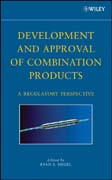
Development and approval of combination products: a regulatory perspective
Siegel, Evan B.
The book covers combination drug product development in preclinical, clinical, and manufacturing stages and ties these perspectives together with a regulatory underpinning that leads to successful product development and FDA approval. It describes the modern, integrated approach to drug-device, biologic-device, drug-drug, and biologic-biologic product development. It presents the basic regulatory principles of combination products, and reviews manufacturing and controls; preclinical testing models; pharmacology; clinical testing; and regulatory submissions, FDA review, and approvals. This is a key reference for professionals involved in developing or regulating combination medical products. INDICE: Preface. Acknowledgements. Chapter 1: Overview of Combination Products Development and Regulatory Review (Evan B Siegel). Chapter 2: Detailed Regulatory Approaches to Development, Review, and Approval (James Barquest). 2.1Introduction. 2.2 General Background. 2.2.1 Definitions. 2.2.2 FDA Organization and Jurisdiction. 2.2.3 Clinical Investigation and Premarket Review Requirements for Drugs, Biological Products, and Medical Devices. 2.2.4 FDA Information Resources. 2.3 Combination Products - Regulatory Background. 2.3.1 Definition. 2.3.2 Intercenter Agreements. 2.3.3. Office of Combination Products. 2.3.4Primary Mode of Action. 2.3.5 Intended Use. 2.3.6 Strategic Regulatory Considerations. 2.3.7 The Request for Designation (RFD) Process. 2.3.8 User Fees. 2.3.9 FDA Meetings - Successful Regulatory Interactions. 2.3.10 Current Good Manufacturing Practice for Combination Products. 2.4 Postmarketing Considerations. 2.4.1 Adverse Event Reporting. 2.4.2 Other Compliance Issues. 2.5 References. Chapter 3: Nonclinical Recommendations for Successful Characterization and Development of Combination Drug Products (Duane B. Lakings). 3.1 Introduction. 3.2 Pharmacology. 3.2.1 Pharmacology and Safety Pharmacology Recommendations for CDPs with Multiple Marketed Drugs. 3.2.2. Pharmacology and Safety Pharmacology Recommendations for CDPs with Marketed Drugs and a Single NME. 3.2.3 Pharmacology and Safety Pharmacology Recommendations for CDPs with More Than One NME. 3.3 Pharmacokinetics. 3.3.1 Pharmacokinetic and Drug Metabolism Recommendations for CDPs with Multiple Marketed Drugs. 3.3.2 Pharmacokinetic and Drug Metabolism Recommendations for CDPs with Marketed Drugs and a Single NME. 3.3.3 Pharmacokinetic and Drug Metabolism Recommendations for CDPs with More Than OneNME. 3.4 Toxicology. 3.4.1 Toxicology Recommendations for CDPs with Multiple Marketed Drugs. 3.4.2 Toxicology Recommendations for CDPs with Marketed Drugs and a Single NME. 3.4.3 Toxicology Recommendations for CDPs with More Than OneNME. 3.5 Conclusions. 3.6 References. Chapter 4: Clinical Pharmacology and Clinical Development of Combination Products (Chaline Brown). 4.1 Introduction. 4.2 Postapproval Clinical Safety Reporting. 4.3 Clinical Development of Drug ?Delivery System Combination Products. 4.3.1 Advantages of a New Delivery Device Drug Product. 4.3.1.1 Streamlined Regulatory Process Possible. 4.3.1.2 Improvement in Efficacy over Previously Approved Delivery Routes. 4.3.1.3 Non-Injection Bioavailability for Peptides and Proteins. 4.3.2 Considerations for a Combination Product with a Novel Delivery Route. 4.3.3 Case Study: Exubera (Pfizers inhaled insulin, approved January 2006) . 4.4 Clinical Development of Drug- Active Device Combination Products. 4.4.1 Case Study: The Drug-Eluting Stent (DES). 4.4.2 Changing Scene for New DES Products. 4.5 Clinical Development of Co-Packaged Combination Products. 4.5.1 Co-Packaged Drug and Biologic Case Study: Interferon and Ribavirin for the Treatment of Hepatitis C. 4.6 Clinical Development of Drug - In Vitro Diagnostic Combination Products. 4.6.1 Retrospective Changes in Drug Labeling to Incorporate Genetic Tests. 4.6.2 ProspectiveCo-Development of Drugs and In Vitro Diagnostics. 4.6.3 Issues Surrounding Biomarker Development. 4.6.4 Clinical Trial Design Issues in Drug - In Vitro Diagnostic Co-Development. 4.6.5 FDA Guidance. 4.6.6 Case Study: Herceptin and HercepTest. 4.7 Clinical Development of Drug - Biologic Combination Products. 4.7.1 Case Study 1: Mylotarg (Monoclonal Antibody Linked to a Cytotoxic Drug). 4.7.2 Case Study 2: Bexxar (Monoclonal Antibody Linked to a Radioisotope). 4.8 Clinical Development of Drug - Drug Combinations. 4.8.1 General Considerationsfor Fixed Dose Combination Efficacy Studies. 4.8.2 Case Study: CombinatoRx, with Combination Therapy as a Business Model. 4.9 Conclusion. 4.10 References. Chapter 5: Regulatory Strategy Considerations for Chemistry, Manufacturing, and Controls: An Integrated Approach (Patrick L. DeVillier). 5.1 Introduction. 5.2 Office of Combination Products (OCP) and Request for Designation (RFD). 5.3Extent of Regulatory Oversight. 5.4 Investigational Device Exemption and Investigational New Drug Exemption. 5.5 Regulatory-Compliant Product Development. 5.6 Chemistry, Manufacturing, and Controls Review Requirements. 5.7 Drug Component Requirements. 5.8 Device Component Requirements. 5.9 Sterilization Considerations. 5.10 Stability Considerations. 5.11 Bench Testing and Early Development Considerations. 5.12 CDP Regulatory Cross-Mapping Guidance and Recommendations. 5.13 Conclusions. 5.14 References. List of Abbreviations.
- ISBN: 978-0-470-05094-1
- Editorial: John Wiley & Sons
- Encuadernacion: Cartoné
- Páginas: 224
- Fecha Publicación: 06/06/2008
- Nº Volúmenes: 1
- Idioma: Inglés
